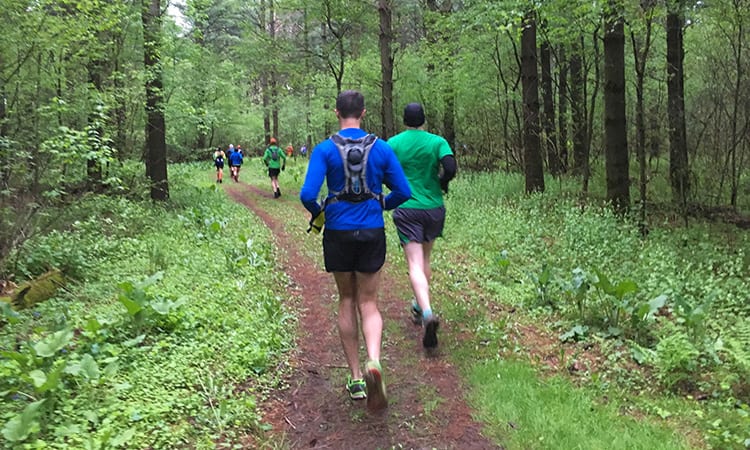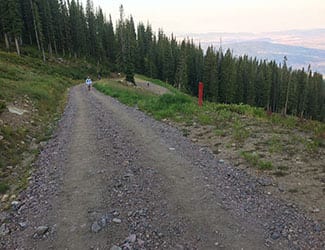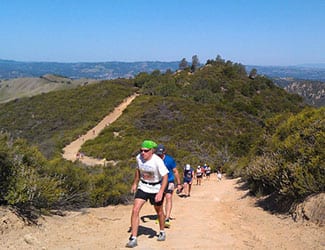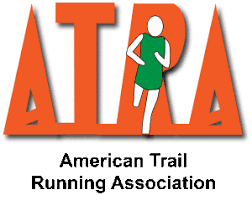By guest author Nancy Hobbs, Founder / Executive Director, American Trail Running Association; republished with permission
Images © RaceRaves

You’ve read a few things about trail running and even had a few friends tell you a thing or two about the sport, but you are still apprehensive about giving it a try. A few trail running tips and suggestions may be just what you need to get you to the closest trail head for your first adventure on the trails.
Tip #1: Identify a trail
Check out our Find a Trail tool powered by Trail Run Project. You can also consult your local city, municipal, or county parks and recreation department, the U.S. Forest Service, a specialty running store, or the Internet for trails in your area. Look for trail race calendars and select a trail race in your area, visit the website, and download the map. Trail races are excellent courses to consider for runs on your own, plus you may like the course so much that you enter the race.
Tip #2: Think time not mileage
Running three miles on the roads may take you 24 minutes while three miles on trails could take you twice as long depending on the elevation changes and the terrain. It is best to plan your run in terms of time, not distance, so that you don’t head out for a run that is beyond your capabilities.
 Tip #3: Keep your eyes on the trail underfoot
Tip #3: Keep your eyes on the trail underfoot
Most trail running injuries occur when a runner glances upward for a split second and immediately is on the ground with a sprained ankle, twisted knee, or bruised hand. To enjoy the view… stop running and look around you. Unless you are stopped, or the trail is completely void of rocks, gravel, tree roots, leaves, ice, or cactus, watch where you are going. Know what the terrain is like under your footfalls. Pay attention to the trail.
Tip #4: Dress appropriately
Always be prepared for what the conditions are, or what they might become. If you are heading out for a 20 minute run, chances are the conditions will remain similar to those at the start of the run throughout the run. However, if you are venturing out for a run of more than one hour consider what the conditions might become. You may start in the sunshine only to experience a dramatic change in weather 90 minutes into the run. What was once bright sunshine is now a sky covered in clouds with thunder rolling in the distance. Hopefully you have carried a wind jacket, tights, or a cap to keep you warm for the run back to your start point.
Tip #5: Know the route
Either take a map with you on an unfamiliar route, or run with someone who knows the area (a great idea for your first trail run is to run with someone and get tips about technique). Getting lost is certainly a possibility especially if you are in a new area, on a new trail, or trying a different route you’ve never tried before. If you are by yourself, let someone know where you plan to run, or leave a note in your car at the trail head that describes the route you intend to run. Safety in numbers is something to consider and running with a friend not only gives you company, but also provides support should you get injured on a run.
 Tip #6: Consider the terrain
Tip #6: Consider the terrain
For your first trail run, start out with a relatively flat to rolling course. Don’t attempt to run up a 14,000-foot peak your first time out the door! Gradually add more elevation, more distance, and more challenge to your run. Challenge can come in terms of footing, steepness of the trail (either ascending or descending), or greater altitude. When you are running uphill be sure to use your entire foot as opposed to running on your toes. Roll through the ball of your foot. Toe runners often have screaming calves at the summit of an ascent. On downhill sections avoid using your breaking muscles and slow down in order to save your quadriceps. You can also use a “traversing” technique on very steep downhill sections similar to a novice skier weaving from right to left across the width of the trail.
Tip #7: Think hydration and nutrition
Drink and eat before your run, during your run, and after your run. The amount you eat and drink will vary based on the duration of your run. If you are going out for a run under 90 minutes, a single water bottle may be all you need. However if it is extremely warm, you may need to consider some electrolyte replacement. Anything beyond two hours and you should supplement with some nutrition as well.
 Tip #8: Invest in a good pair of trail running shoes
Tip #8: Invest in a good pair of trail running shoes
Your seven ounce racing flats may be the perfect shoe for your 5km road race, but won’t be a good choice for the trails. A shoe with good support, stability, gripping potential, and comfort is essential for the trails. There are numerous trail shoes on the market ranging from light and quick (those that are appropriate for short uphill runs), to mid-weight and reinforced (appropriate for longer runs with more gnarly terrain), to heavy and extremely stable (appropriate for short, rocky, ever-changing terrain). A good all-purpose trail shoe is one that is a good transition shoe, one that will perform well on short sections of road as well as the trails. There are few people who live right next to a trail head so it is helpful to select a shoe based on where you will be doing most of your trail runs. Need help selecting which trail running shoe is right for you? Check out our Research Trail Running Shoes page.
Enjoy yourself and set achievable goals. For more about trail running explore trailrunner.com for events, news, links to other trail running resources and more.
And here are some helpful guidelines for trail running in the time of COVID-19, from ATRA President Adam Chase.
(Updated July 15, 2020; originally published Nov 21, 2017)
ABOUT ATRA
The American Trail Running Association, ATRA, was formed in mid-1996 as a Colorado not-for-profit corporation to serve the mountain, ultra & trail (MUT) running community. Their mission is to represent and promote mountain, ultra & trail running. They offer individual, club, race and corporate memberships. One of their primary benefits is their quarterly newsletter, Trail Times, which includes a national events calendar, thoughtful articles, and timely information about the sport.
Find your next road or trail race on RaceRaves using our powerful, easy-to-use Find a Race search engine — select “Trail” as the terrain along with any other relevant criteria (distance, date range, location/zip code, etc) and even sort by ratings.
Find this article informative? Please share it, and let others know RaceRaves is the premier online resource to DISCOVER, REVIEW & TRACK all their races and to CONNECT with other runners!
Other RaceRaves articles you’ll enjoy (trust us!):
Virtual Racing: Takeaways from the RaceRaves Community
Quick 6: Race Trivia Series
So Your Race Has Been Canceled. Now What?
Runners Choice: Best Half Marathons in the U.S.
Runners Choice: Best Marathons in the U.S.
Best Bets for Boston Marathon Qualifying Races
Unconventional Races that dare to be different
And for more helpful articles, check out our blog!

No comments yet